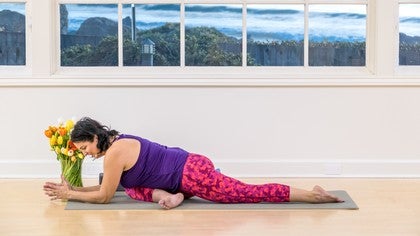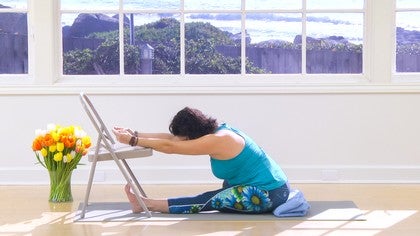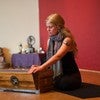Description
Transcript
Read Full Transcript
Namaste. Welcome to unwinding the hips and working with the pelvis. Tell you a little bit about the class. You're going to learn a mudra, pran mudra. This is a mudra for the bones, but it also is very, very helpful to the pelvis and the way that the femur head sits in the acetabulum in the hip socket itself. We're going to go through some floor movements that allow the hips to open softly and then into standing poses. Coming in and out of the standing poses from the ground up. You ready? So, mudra. This mudra we call, sometimes we call it the boy scout mudra. Put your hands just like if you were a boy scout, right? Not sure about that. Maybe you're a girl scout. You're going to peace sign, but bring the fingers together just like this. Now, this part of the hand, it stays in a circle. So it's not like a coyote, right? It's not like a coyote. It is more like a rabbit. This is pran mudra. You can rest your hands for a moment just like this and really you can rest them in any way. And there will be some times during the class when you won't be able to do the mudra. You'll see, it's quite nice. What this will help with the practice is it gives your mind a focus and it gives you an intention that puts it the direction straight back into the root chakra, straight back into the bones of the pelvis and into the grounding mechanism of the class, right? So one more time. It looks like this, right? Boy scout mudra or peace sign. Fingers together. You rest the hands. There'll be different ways it will rest the hands throughout the class, but you'll catch on. It'll be great. Okay, so let's get started. You're going to come to hands and knees to start. The first thing that I like to do is a pigeon. So you want to have a block handy. You can have a blanket handy. We'll start out from hands and knees and we're just going to slide the right leg forward. Now, if you've gone to some yoga classes, you're familiar with pigeon. And if you haven't, you're going to love this. This is fantastic. This foot uncurls. This leg is as straight as it can be. The key to this posture is that you are resting on your hip. You want to rest soundly on the hip. If you're not, then you're going to dangle on the shin and that actually causes tension in the pelvis. So you're going to take your blanket or maybe for you a block and you'll place it underneath that elevated area so that you can rest the pelvis down. If you don't need that, it's fine. Just rest. And you'll know, like sometimes you can get the pelvis down, but you're way over here and you're going to fall over. Don't do that. Like just put a prop under there. Just trust me. Put a prop under there. You'll like it more. So once you're here, you glance back at your back leg. There it is. It's not like this. It's rolling all the way down. You're thinking about the back leg hip point is moving towards the ground and see if you can bring the elbows down. Now here's an interesting thing. If you can't bring the elbows down because it's just like, you get kind of stuck. You can use your block. Sometimes even higher. Maybe even a chair. You decide what you need. But for the purpose of showing you this, I'm going to come all the way down to my elbows and I'm going to bring my palms together as in Anjali Mudra. I'm going to sort of settle in. Now, I love this pose. We do it a lot in my classes, don't we? Yes, we do. So the reason I love it is because it's going to work an aspect of the body. You probably already feel this in your right rump. It's working your piriformis muscle. I'm going to root this bent leg and try to drag it back. It's not going to go anywhere. It's stuck on the mat. And I'm going to root the back leg and try to drag it forward. It's not going to go anywhere because it's stuck on the mat. But those two actions, those two scissoring actions, actually increase the stretch to the piriformis, which you may already be feeling right now. So we're here. Some of you may find that you can take the arms out a little bit more. Some of you may find you can take the arms all the way out and even rest the head on the floor. And that is fine to do as long as you're not straining. No straining. So the straining is a B-A-D. So I'm scissoring the legs, but I'm also narrowing my front hip points. And you can think about it like this. Like when you pull a shoelace up and right where the shoelace crosses, how it tightens up there, you want the hip points to narrow and kind of firm up just a little bit. You're still scissoring the legs. Now that firmness eases as you inhale and it increases a little bit as you exhale. This is just a little undulation that goes on in the pelvis. It's quite nice. You should feel a lot going on in your right rump. So if you're not, you might want to scissor just a little bit more. Stay in that beautiful space. Don't go more than like 80% your effort or it sort of starts to undo the benefit. Get some done. A few more breaths.
Can reach the chest and then soften the back of the neck. Reach the chest, scissor a little more with the legs and then soften. To come out, place our hands. I'm going to curl the back toes under and lift the leg off the ground. My toes are still on the ground, but I'm firming the leg and straightening it. I'm going to increase the movement of the belly where the hip points narrow. They're narrowing towards one another and I'm pulling a little bit up toward the heart and then I just float my leg back right back into downward dog. I feel so good. You can feel that in the legs. The piriformis on that right side is quite happy on that front leg. And we have another leg. Now, if that was really difficult for you, you're grateful that there's only one more leg. What if we had four legs? So you have four piriformis. That would be rough. So we're going to go the other side, slide it forward. Same rule applies. So if you get the hip down, you're falling way over to the side. Not going to be able to do that. You're going to have to take your blanket and support that hip. The reason for that is the dangling nature. If I just dangle here, deep tension develops here. The piriformis won't fully open. It's got to hang on because it's got to create the scaffolding for the body. And there's also tension that can go in the knee. So it's really not suggested. If you can get some good foundation there, do that. Again, use your prop if you need to. If this is too low, prop yourself up. Get ready. We're going to scissor the legs. I want you to peek back at your straight leg. Go on and look at it. Make sure it's rolling under. Make sure that back leg hip point is moving towards the ground. And then start the scissoring process. Now, if this is your tighter side, then there's even more sensation. Congratulations. If it's not so much the tighter side, there is an opportunity to create more intelligence on that side. So our easy side tends to be sort of, the volume goes down really with the easier side. Maybe if this is your easier side, you could keep the attention very honed. Not efforting more than 80% your effort. Keeping that in mind. Making the determination, can I extend the arms? How low can I go without straining myself? What feels appropriate? Can I be here and not be more than 80% my effort of the legs? Or is this overdoing it? You make that determination for yourself. Decide what's going to work. Take some breaths, breathing in that area that's creating the most sensation, which for most of us is going to be in the rump itself, in the piriformis muscle. One more breath. And slide back. Curl the toes under on the back leg. Again, it's going to lift off the ground. It's up for the toes. You're going to firm the belly, straightening yourself up, and rolling back into downward dog. Relaxing the back of the neck. Softening the inner corners of the eyes. Now just float yourself down to your knees. So that was a nice opening for the back body, for the piriformis. Now we're going to do a little opening for the front body. This posture is a modified Utstrasan. Now sometimes in this posture, it's really not comfortable to the knees to this posture for some people. If that's you, I'd like for you to come to kneeling like this. You can place your hands on your hips.
Even better, place your hands on the back body, right at the sacrum, right at the hip here. And allow yourself to lift and open in this way. So we're opening the front part of the pelvis, the flexors. And any time that we're doing this modified Utstrasan, you can do it in this way. If your knees are fine and you can sit on the feet, take your hands back behind. Fingertips pointing away from one another. Let the chest begin to open. And you can lift just the chest and keep the head forward. Or just the chest and release the head back. Or the chest and the pelvis but keep the head forward. Or the chest and the pelvis and release the head back. You decide. I want you to avoid like collapsing. This isn't necessarily the best thing to do with your neck. I want you to feel like you're elongating the neck. And if it gets tired, just look forward again. Pretty simple. Sitting back down. Bringing yourself to sit on the feet. Let's bring the hands now to Pranmutra. Take a moment in this posture. As you're sitting, you're feeling the quietness of the pelvis. There's like a quietness descending in the pelvis. And a quietness in the spine ascending.
All right. So there's this quiet lift and this quiet release. Hands in Pranmutra. Remember in the mudra, your hands aren't tight. Your hands are, you know, they're very, they're very aware. I was going to say soft but the contact of the fingertips is soft. The hand itself is at that perfect place of extending. Not too hard, but not lax either. Now from this Vajrasana, we're going to move into child's pose and I'm going to keep my hands in Pranmutra. And just move right into child's pose. Relaxing the back of the neck. Remember the Pranmutra is helping to create a kinder relationship in the bones of the pelvis. Now I'm going to unfurl my hands nice and quietly. Bring the hands a little closer and come again to hands and knees. Go ahead and lengthen the front chest forward and bring yourself into downward facing dog. So downward facing, now don't be in Pranmutra right now. I'm sure you're not, but just saying. From your downward dog, you get two options. We show you what we're going to do. We're going to move into plank position. If this is beyond 80% your effort just to be here, you're going to lower your knees directly down. Don't take them way up here. I want to back a little bit because I still want that feeling of the abdominals drawing in and up. Because plank position, it's about the front body and it's about firming the front body. Your hip points are narrowing again. And if you can, you're feeling like your inner thighs are rolling up. There's a long reach to the back of the neck. You're not going to lift your head like this. You're just going to let your head be facing straight forward so there's a quietness in the neck. Bringing yourself to downward facing dog now. Coming on down to your knees. Sitting on back or kneeling so you decide what it is that you need. Where does your head need to be? Your neck? Does your pelvis need to lift? Or should you just be lifting your chest? What's going to work for you today? Forward back into downward facing dog. And down to your knees. It's a simple sequence possibly in the mind but a profound sequence for the body. So as you sit back on the feet, turn the hands again to prawn mudra. I kind of look at this like the way I plug in my cell phone. I'm like plugging in. I'm plugging in and re-energizing through the matrix of the hands and the nervous system. Eyes are soft. Remember when there's tension in the eyes? That means there's tension somewhere in the body. And you can consciously soften your eyes and soften the related tension elsewhere. That's like my favorite yoga trick. Can you soften your eyes in the argument? It's pretty cool. So let's go again. We're going to move into a child's pose. Keep the hands in prawn mudra. Into hands and knees. Into downward facing dog. Feeling that beautiful breath move through the body. Into your plank. What do you need for your plank? Do you need to drop your knees? Drop your knees. Can you narrow the hip points? Can you firm the belly? Not only in but slightly up toward the heart? Can you flatten the shoulder blades? Can you allow the muscles to deepen into the bone?
And can you do all of this at 80% of your effort? Not more than that. Roll yourself back now. Downward facing dog. Roll yourself forward. Back we go to Woodstrassen. You pick. Where does your neck need to be? Where does your chest need to be? Can you, as you create this posture, not force the pelvis up but actually ask the inner thighs to drop down so that the sacrum eases into the pelvis without strain? Rolling your way down. Rolling your way into a downward facing dog. Coming back to Vajrasana. Coming back to prawn mudra. So notice your eyes. Notice the quality of the hands. And it may be that the hands are starting to get a little cranky with the mudra. That's very normal. This is a new posture. It's like a new posture with the asana. If they get too cranky, you just flatten your hands on your lap. It's fine. You can come back to it in a little while. One last one. We're gonna move into our child's pose. Holding onto the prawn mudra. Aware of the breath.
Releasing the hands. Coming to hands and knees. Rolling the toes under. Coming to downward facing dog. Shifting forward into your plank. What is your plank gonna look like? Maybe you're gonna drop to your knees this time. Or maybe you've been on your knees and you think, hmm, maybe I'll straighten for this last one. Hip points narrowing. Inner thighs reaching up to allow the sacrum to drop a little deeper. Shoulder blades are firm. When you're ready, you're gonna ease your way back to downward facing dog. Ease your way down to hands and knees. To this beautiful modified ustrasan. So you're taking the time and using your intelligence with the feedback from your body to choose what's gonna work for you. Coming all the way forward. One last downward facing dog. Even here the inner thighs can pull back. The hip points can narrow slightly and the sacrum feels like it drops a little more deeply into the body. Such a beautiful combination of movements. Down to your knees. One more time. Coming to pran mudra. Letting your eyes close. Conscious of the breath. Conscious of the sensation of the hands and the body. Mudra is continuing to unwind any hardness in the pelvis, any hardness in the legs. So that we have a supple body. Supple means strong and flexible. Supple means healthy. Releasing the posture now. So now, now we're gonna move into a sequence where you get to taste each of the standing poses that we'll be working with. The first will be triangle pose. So just follow along. Coming to hands and knees. From hands and knees you're gonna step that right leg forward. Now go ahead and grab your block and put your block beside the front leg ankle. And coming from the ground up we straighten both legs and we unfurl right into the titatric canasana. Just letting the body taste the posture for a moment. Feeling the hip points narrow. Feeling the sacrum have the room to deepen. Feeling the breath. Unwinding. All the way back down. Back down to the knees. Back down to hands and knees. From here you relax the pelvis. So it's over. That sequence is over. So we're back to a neutral place. And then we'll move to the second side. Bringing the opposite leg forward. Placing the block right by the ankle. And again, if it was hard for you to straighten your leg, maybe the block needs to be higher. Or maybe you even need the seat of a chair. Either of those are fine. You just do that.
I'm gonna straighten my legs. I'm gonna unfurl into the titatric canasana. My hip points narrow. My belly draws in and up. My sacrum, it feels like it goes deeper into the body. Notice your eyes. Feel the peacefulness of this. So peaceful. Peaceful in the pelvis. Peaceful in the mind. Unwinding going right back. Back to hands and knees. Back to downward dog. Nice long spine. And back to vajrasana. Hands to prana mudra. Pose number two, uttita parsvokanasana. Rolling forward. Hands and knees. Right leg steps forward. And in the class about coming from the ground up, I mentioned if you feel wobbly, the front leg can move to the side a little bit. You're welcome to do that. This time the brick goes by the little toe on that front foot. Same idea, I'm straightening the back leg, but the front leg is gonna stay bent. And this arm I'm gonna take up and all the way over and just lengthen the whole side of the body. If it feels comfortable to the neck and the chest, you just rotate a little bit looking up towards the sky. Notice your eyes. Even here the hip points are narrowing. Eyes tone, the sacrum's deep. Feel that beautiful living breath moving through you. And then you're going to unwind yourself. All the way back down. Back to hands and knees. Moving to the second side. Opposite leg comes forward. Have you figured out what the easy, more open side is compared to the not so easy open side? I love that part. Like hello, left hip. Straightening the back leg with the front leg stays bent. I'm supporting myself with the block. And again, you could go higher if you need to, even to that chair seat. It's fine. You need to do what works for your body. You know, if you listen to your body, you will really develop your intuition. And your body will start to give you all kinds of beautiful secrets. But if you force your body, then it kind of doesn't make it very happy. Moving into utti taparsva kanasana. Spinning if it feels good. Turning the head if it feels good. If it doesn't feel good to your neck to turn your head up. I want you to turn your head down. Your body's your friend. Years ago I remember Eric Schiffman saying, that's you in there. What are you doing? And I really hit home. I was like, oh yeah, what am I doing? Back down you go.
Back to downward facing dog. Here we go. The final pose in the sequence. This gets a little crafty. So come along with me. Use your block if you like. I'm going to step the right foot forward. I'm going to plant this foot. This front foot stays planted. Goes my block. I'm going to slide it out. Lift myself up. All the way into artichandrasana. Now in the artichandrasana, maybe this is really crazy for you. If that's the case, you could get an extra block and just be here in the beginnings of a standing split. This is a lot of information for the body. So if you feel wobbly, you could either move against a wall or bring both hands down. It doesn't really matter. What are we doing? We're helping the body to investigate itself. So you have to choose what will work best for you. Coming all the way back down. Let's take a downward dog. Going to the second side. I love the second side because this is where the mind thinks it knows what's going on. It kind of does, but not really. Obviously it steps forward. So right now my mind, even my mind wants to hurry. It's like, I know what to do. It's like, well, but do you know what's going to happen? Because both sides of the body can be so different. They can be so different. Choosing where you need to be is a sign of an intelligent yogi. Forcing yourself to be where you really aren't ready to be is a sign of a, I think it's a sign of a crazy person actually. So don't do that. Let's let the yoga practice make us more sane. Back down we come. Here we go. Hands to pran mudra. Get a feel for this. We're going to come to standing and we're going to throw it all together. It's going to be amazing. We're also going to add pran mudra. We're going to add it in the middle of the sequence. And once you do this one time, you're going to just totally fall in love with it. I can't wait. Okay. So, so we'll stand. Come on. You're going to need your block. Bring your block up close. You might need some flowers. So you're standing at the top front of your mat and you're standing in tadasana. Go ahead and sort of, we've been down there a little while. So go ahead and wheel around a little bit. Feel, just kind of feel yourself. Feel your feet. Bring in the hands to pran mudra. This can point down. So you're feeling the movement of the energy down, grounding into the feet, but you're also feeling that feeling of the energy rising up by creating that soft tone in the belly, that lift, the narrowing of the hip points, and the depth of the sacrum.
So all these things are going on simultaneously. A lift and a release. A lift and a release. Take a deep breath. And then let's take the arms up. Floating the arms up. Getting nice and long. Imagine you're like a rubber band. You know how a rubber band gets kind of thin in the middle. So you're lengthening, lengthening, lengthening, lengthening, lengthening. And then you're folding, folding, folding, folding. You can keep your hands in the mudras if you like, particularly if your hands aren't reaching the ground. If they're on the ground, you can release and clasp the elbows. A nice uttanasana, feeling balanced in the feet. Take the hands to the floor now. Step your way back to a downward facing dog. And we come to the knees. That right leg comes forward. You have your block handy. We're moving first into uttitatricanasana. So roll your way up there. Unfurl the body. Feel the engagement of the hip points, the depth of the sacrum, the tone of the belly. Feel the wideness of the heart. And take that top hand into pran mudra. Feel the feet. When you take that mudra over time, you'll feel the whole body connect with the earth. It's really amazing. Here we go. We're going to release the mudra. Coming back to this beginning position. Now soften the pelvis. Go quiet. You really try to erase the fact that we're about to do another posture. You're just here.
Slide the block forward. We're going to stay with the front leg here and move into tittiparsvokanasana. Taking that arm up and over. Taking the top lifted hand into pran mudra. You spiral if spiraling feels good. If it feels straining, don't spiral. The hip point's still narrow. Take them deep. Hand in mudra. Notice your eyes. And we unwind. All the way back down. Back down to this kneeling position. Back down to the quietness. So there's no forward movement. There's just this quietness. Just for a moment so that the hips can re-center. You probably know what's coming, right? Slide the block forward. Bring yourself all the way up into artitandrasana. And yes, hand goes to mudra. Hand goes to mudra. It's possible that you need to have both hands down. And you're just here in standing splits. This is also fine, but don't take the mudra. Let the hands be there to steady you. We unwind ourselves. All the way back down. Stepping back to hands and knees. Coming into downward facing dog. Walking your hands to your feet. So you're going to end up toward the back of your yoga mat. Rolling yourself up. Taking the mudra now in both hands. And then bringing the arms back down. Notice your eyes. Keep the eyes soft. Taking a quiet meditative walk to the front of your mat. Hands remaining in mudra. Eyes remaining soft. Just a singular journey. Just you and your body and your mat. Maintain the mudra. Float the arms up. Second side. Reach through the arms. Soften through the eyes. Even the jaw is soft. Be aware of even the jaw. As you fold forward again, if the hands come to the floor, go ahead and clasp the elbows. If they don't, hold on to the mudra. It's fine. Coming to downward facing dog. By now you may be feeling the effects of the mudra. Feeling the effects of coming from the ground up. It's very cooling in the brain. Even though your body is probably sweating a little bit. From hands and knees, this time we're going to step the opposite leg forward.
We're rolling right into utti tatrikanasana. No straining. Just feeling the relationship of the pelvis at the hip points. Sacrum deep. Belly toned. Heart is full. Eyes are so soft. Hands softly goes into prana mudra. Feel the mudra. Feel that connection. Here's the alchemy. Feeling like a symphony. Like a poem. Unfurling the body now. Coming to hands and knees. Coming to downward dog. Coming to the next posture. Same leg steps forward. Utti tatrikanasana. Back leg straightens. Front leg stays bent. And the arm up and over. Hand to mudra. You determine do I spin and spiral and open the chest? What am I needing right now? Is it good on my neck or is it straining something? Do I need to look down at my foot? This is your body. You decide. Unfurling. All the way back to hands and knees. And for a moment just pause. Pause and grow quiet in the pelvis. Notice your eyes. Soften them at their heart. Keep them soft as you go into downward facing dog. Hands and knees. Same leg comes forward.
Are you ready? Gather the toes up in the back. Slide yourself forward. Either as standing splits or opening to Ardachandrasana. If you don't need the block, you don't have to use the block. Hand to pran mudra. Finding the steadiness. Finding the sweetness of the breath. Down winding. Back to hands and knees. To downward facing dog. Hands to feet. Hands to pran mudra. For this final one, look to your thumbs. Maintain the pran mudra as the arms float back down. And then walk yourself very quietly to the front of your mat. Meditative breaths. The palms together to your heart to acknowledge your salutation to the sun. And then lower to a squat. Step back. Let's sit in Vasarasana again. Take your hands to pran mudra. Take your body to child's pose. Downward facing dog. Plank. Woodstrassan. You pick. What do you need in Woodstrassan? And finally, head supported child's pose. Just notice the sweetness of your breath. Maybe you got a little warm in the practice. Notice the quality of your brain. And of course, your eyes. Every exhalation relax a little more deeply. And softly open your eyes. Quietly bring yourself up. And just spin around. We're going to lay on our back. You don't need anything under your head or under your legs that's lying on the back. Extend your legs and extend your arms. Every so often, this is challenging to the back. And if that's you, bend one of your legs a little bit so that you're not uncomfortable in your back. Reach the feet away from the hands. Keep the eye quality quiet. Take a breath or two here. Now your spine is extending. And when you inhale naturally, the spine does a little bit of an extension. So this will be the inhalation position. There's plenty of room for your lungs to expand. And the spine is moving in the direction that's the most natural for the inhalation of the breath.
Curl the legs in now, either one at a time or at the same time. And hold the legs with your arms. Take a few breaths here. Your spine naturally softens into a slight curve when you exhale. It's the natural movement of the spine on the exhalation. Therefore, this position is the exhalation position. So the next time you feel yourself ready to inhale, straighten the legs, either one at a time or together, and inhale. And as you exhale, bring the legs together either one at a time or at the same time. Pulling the legs in to help express the air from the lungs. See that a few more times. Inhaling, reaching, exhaling, closing the body. Follow your unique rhythm of your breath. Maybe your inhalation lasts a little longer than mine. Maybe your exhalation is a little longer or shorter. Three more on your own. Make sure the feet make contact with the ground. So don't hover the legs. On your next exhalation, we're going to change the legs as you inhale. This time my legs are going to go straight up and my arms over my head. Exhaling is the same. This is a nice modification. Inhaling, legs straight up, arms overhead. Exhaling, holding the legs. Three more on your own. Following your breath pattern, not your neighbors, not mine. Now let the feet come to the floor. Take your hands to your pelvis. Allow your eyes to soften again. Notice how you feel. Notice the quality of your eyes. Now we're almost to Shavasana, the resting at the end of class. One last thing. I want you to take your block. The block has three settings. It has a low, a medium, and a high. I want it to be on its lowest setting. I'm going to lift the pelvis and slide the block underneath in a comfortable spot of the pelvis. Hands go back to the body. I'm going to take a few breaths here. Position your feet so that your legs can relax towards one another and soften the belly. If it's comfortable for you, let your eyes close. Count five exhalations. Now press the feet a little more into the floor. Lift the pelvis. Slide the block out.
Roll to your side. Towards your navel to sit up so your head remains relaxed. Super important. So now we're going to take our Shavasana, and this is by far the most important part of the class. So toward the end of the class, when I say we're done and go on and get up, if you feel really, really relaxed and really good, you might even fall asleep, stay there. It's fine. You're going to make a roll with your blanket. This roll is going to support your thighs. Place it about right there on your mat. And when you lay down, you're going to use your legs to pull that blanket nice and close to the pelvis. And then slowly extend the legs. Now if you're working with any type of back issue, this could be bigger. You could just make a thicker blanket. It's fine. Once the legs are extended, you're going to relax the legs. Even if they kind of flop out, it's fine. Relax them. Arms out to the side. Press the arms down slightly. Lift the chest and flatten the shoulder blades to the floor. Now for most of us, that's comfortable. Some people need to wiggle a little bit more. So wiggle until you feel really good where you are. Eyes soften, breath softens, body softens. Feeling deeply relaxed. Every part of the body is heavy and relaxing down into the ground.
Any remaining tension soaking into the ground. You're watching the breath. Any place in the breath that feels a little sticky, soften that area. Use your mind. Ask it to surrender itself. Feel that beautiful life force moving in and out of your body. Letting all the resistance go. Vishas. Vigneshas. Vigneshas. Vigneshas. Vigneshas. Vigneshas. Vigneshas.
Vigneshas. Vigneshas. Vigneshas. Vigneshas. Vigneshas. Vigneshas. Vigneshas. Vigneshas. Vigneshas.
If you feel deeply relaxed remain in your savasana. If you feel ready move the body roll to the side and quietly sit up. Listen to Anjali Mudja. It was my great pleasure to be with you today. Namaste.
Yoga Alchemy
Comments
You need to be a subscriber to post a comment.
Please Log In or Create an Account to start your free trial.






















